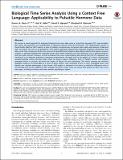| dc.contributor.author | Dean, Dennis A. | |
| dc.contributor.author | Adler, Gail K. | |
| dc.contributor.author | Nguyen, David P. | |
| dc.contributor.author | Klerman, Elizabeth B. | |
| dc.date.accessioned | 2014-10-17T18:43:46Z | |
| dc.date.available | 2014-10-17T18:43:46Z | |
| dc.date.issued | 2014-09 | |
| dc.date.submitted | 2012-09 | |
| dc.identifier.issn | 1932-6203 | |
| dc.identifier.uri | http://hdl.handle.net/1721.1/90972 | |
| dc.description.sponsorship | National Space Biomedical Research Institute (NASA NCC 9-58 HFP01603) | en_US |
| dc.description.sponsorship | National Space Biomedical Research Institute (NASA NCC 9-58 HPF00405) | en_US |
| dc.description.sponsorship | National Institutes of Health (U.S.) (NIH NCRR-GCRC-M01-RR-02635) | en_US |
| dc.description.sponsorship | United States. Air Force Office of Scientific Research (AFOSR F49620-95-1-0388) | en_US |
| dc.description.sponsorship | United States. Air Force Office of Scientific Research (AFOSR FA9550-06-0080) | en_US |
| dc.description.sponsorship | National Institutes of Health (U.S.) (NIH P01-AG09975) | en_US |
| dc.description.sponsorship | National Institutes of Health (U.S.) (NIH T32 HL07901-10) | en_US |
| dc.description.sponsorship | National Institutes of Health (U.S.) (NIH F31-GM095340-01) | en_US |
| dc.description.sponsorship | National Institutes of Health (U.S.) (NIH K24-HL105664) | en_US |
| dc.description.sponsorship | National Institutes of Health (U.S.) (NIH K02-HD045459) | en_US |
| dc.description.sponsorship | National Institutes of Health (U.S.) (NIH RC2-HL101340) | en_US |
| dc.description.sponsorship | National Institutes of Health (U.S.) (NIH R01-AR43130) | en_US |
| dc.description.sponsorship | National Institutes of Health (U.S.) (NIH K24-HL103845) | en_US |
| dc.description.sponsorship | National Institutes of Health (U.S.) (NIH R01-MH071847) | en_US |
| dc.description.sponsorship | National Institutes of Health (U.S.) (NIH R01 HL098433) | en_US |
| dc.description.sponsorship | National Institutes of Health (U.S.) (NIH R01 HL098433-02S1) | en_US |
| dc.language.iso | en_US | |
| dc.publisher | Public Library of Science | en_US |
| dc.relation.isversionof | http://dx.doi.org/10.1371/journal.pone.0104087 | en_US |
| dc.rights | Creative Commons Attribution | en_US |
| dc.rights.uri | http://creativecommons.org/licenses/by/4.0/ | en_US |
| dc.source | Public Library of Science | en_US |
| dc.title | Biological Time Series Analysis Using a Context Free Language: Applicability to Pulsatile Hormone Data | en_US |
| dc.type | Article | en_US |
| dc.identifier.citation | Dean, Dennis A., Gail K. Adler, David P. Nguyen, and Elizabeth B. Klerman. “Biological Time Series Analysis Using a Context Free Language: Applicability to Pulsatile Hormone Data.” Edited by Ioannis P. Androulakis. PLoS ONE 9, no. 9 (September 3, 2014): e104087. | en_US |
| dc.contributor.department | Massachusetts Institute of Technology. Neuroscience Statistics Research Laboratory | en_US |
| dc.contributor.mitauthor | Dean, Dennis A. | en_US |
| dc.contributor.mitauthor | Nguyen, David P. | en_US |
| dc.relation.journal | PLoS ONE | en_US |
| dc.eprint.version | Final published version | en_US |
| dc.type.uri | http://purl.org/eprint/type/JournalArticle | en_US |
| eprint.status | http://purl.org/eprint/status/PeerReviewed | en_US |
| dspace.orderedauthors | We present a novel approach for analyzing biological time-series data using a context-free language (CFL) representation that allows the extraction and quantification of important features from the time-series. This representation results in Hierarchically AdaPtive (HAP) analysis, a suite of multiple complementary techniques that enable rapid analysis of data and does not require the user to set parameters. HAP analysis generates hierarchically organized parameter distributions that allow multi-scale components of the time-series to be quantified and includes a data analysis pipeline that applies recursive analyses to generate hierarchically organized results that extend traditional outcome measures such as pharmacokinetics and inter-pulse interval. Pulsicons, a novel text-based time-series representation also derived from the CFL approach, are introduced as an objective qualitative comparison nomenclature. We apply HAP to the analysis of 24 hours of frequently sampled pulsatile cortisol hormone data, which has known analysis challenges, from 14 healthy women. HAP analysis generated results in seconds and produced dozens of figures for each participant. The results quantify the observed qualitative features of cortisol data as a series of pulse clusters, each consisting of one or more embedded pulses, and identify two ultradian phenotypes in this dataset. HAP analysis is designed to be robust to individual differences and to missing data and may be applied to other pulsatile hormones. Future work can extend HAP analysis to other time-series data types, including oscillatory and other periodic physiological signals. | en_US |
| mit.license | PUBLISHER_CC | en_US |
| mit.metadata.status | Complete | |
